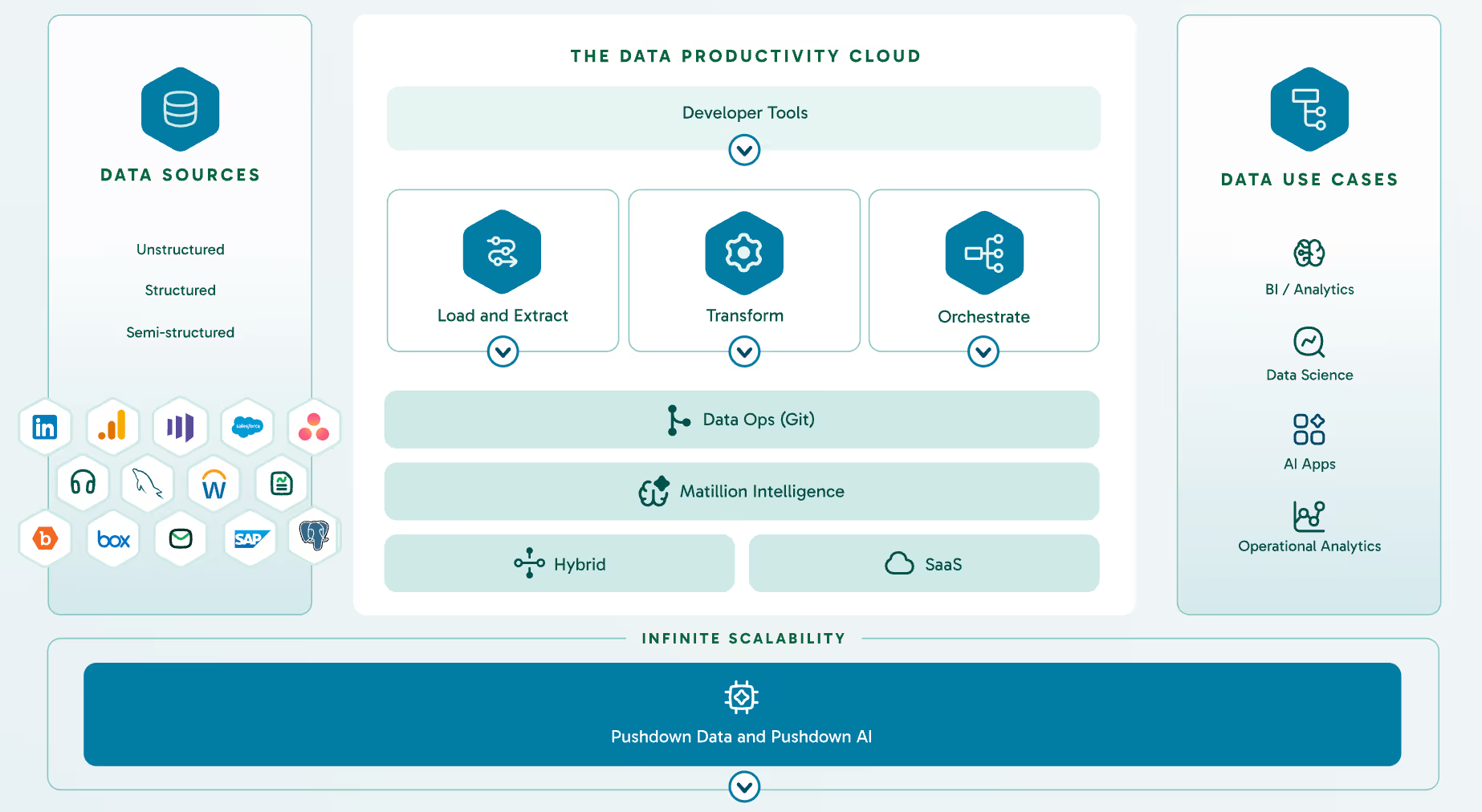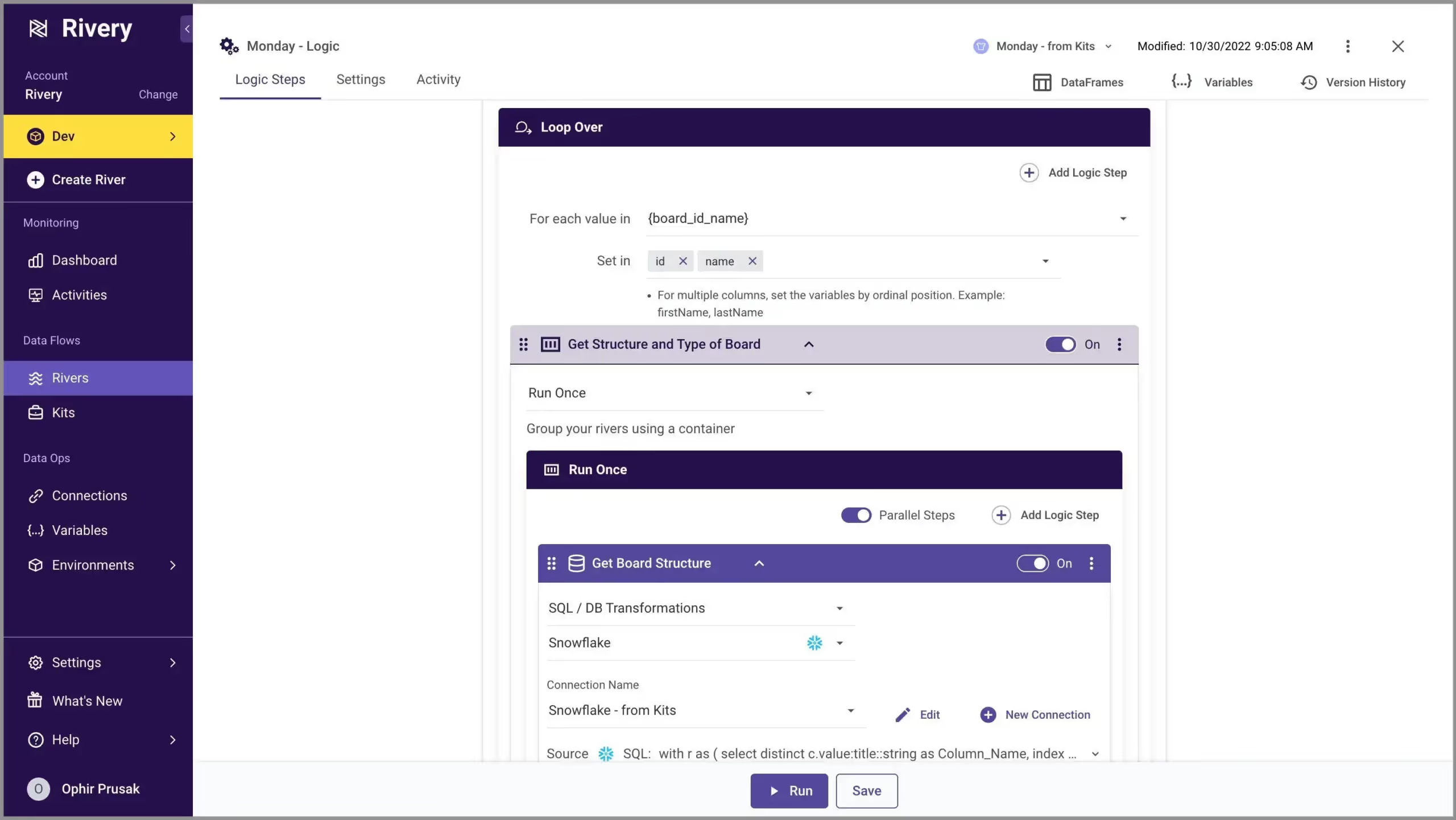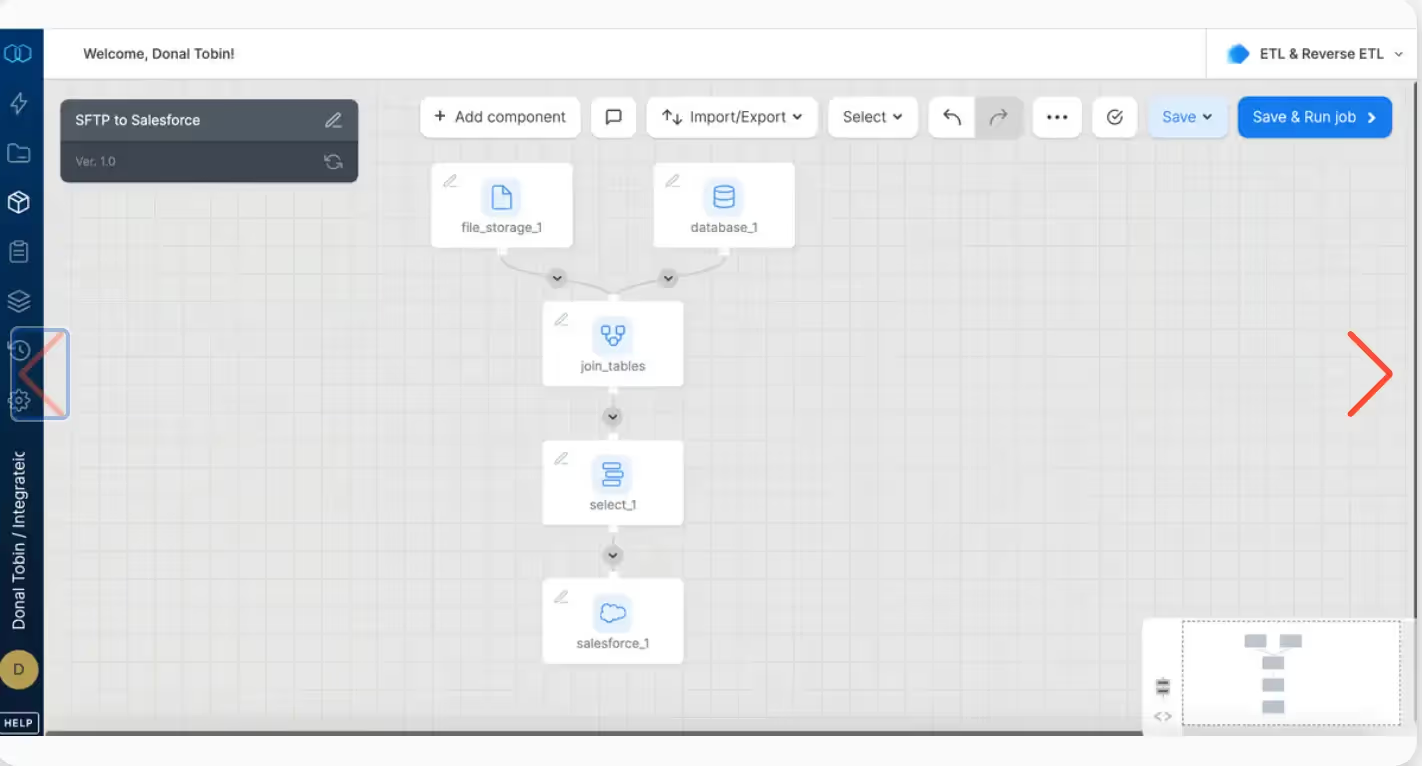Best Airbyte Alternatives 2025: Top Cloud & Open-source Solutions for Data Integration


Table of Contents
TL; DR
- Airbyte: Popular open-source ELT tool with 200+ connectors. Free to use, flexible, but limited by unstable connectors, no native transformations, resource-heavy deployments, weak observability, and scaling bottlenecks.
Top Airbyte Alternatives (2025):
- 5X – Full-stack data platform (integration, transformation, orchestration, BI). 500+ connectors, real-time, pay-as-you-go. (G2: 4.5/5)
- Portable – Best for niche/legacy connectors, managed builds. (G2: 4.9/5)
- Matillion – Cloud-native ETL/ELT, strong orchestration & transformations. (G2: 4.4/5)
- Rivery – No-code, real-time ELT with DataOps features. (G2: 4.7/5)
- Integrate.io – ETL/ELT with drag-and-drop, real-time + batch support. (G2: 4.3/5)
- Estuary.dev – Real-time streaming and event processing. (G2: 4.8/5)
- Talend Open Studio – Open-source ETL with governance. (G2: 4.3/5)
- Apache NiFi – Flexible, real-time flow management. (G2: 4.2/5)
- Apache Airflow – Complex workflow orchestration. (G2: 4.5/5)
- Pentaho – Open-source ETL with graphical design. (Community & Enterprise editions)
Bottom line: Airbyte = great for OSS integration, but high maintenance. If you want end-to-end simplicity and scalability, go with 5X. For niche or specific use cases, tools like Portable, Matillion, or Estuary may be better fits.
Airbyte isn’t always the silver bullet for data integration that it claims to be. While it’s gained popularity for its open-source approach, many data teams find themselves bogged down by its limitations.
The reality is, Airbyte's connectors often lack maturity, requiring constant maintenance and custom fixes. Performance issues, especially with larger data volumes, can quickly become a bottleneck.
For data engineers dealing with complex pipelines or needing real-time data sync, these problems aren't just minor inconveniences — they can cripple productivity. Fortunately, there are several proven airbyte competitors that address these pain points head-on
In this article, I've listed the 10 best Airbyte alternatives, both open-source and cloud-based, that offer ELT, ETL, and other data integration and transformation capabilities. But before we dive into these tools, let’s briefly discuss what Airbyte is and where it falls short.
What is Airbyte and what is it used for?
Airbyte is an open-source data integration platform designed to handle ELT (Extract, Load, Transform) processes. It provides a modular framework for building custom data connectors, allowing teams to easily sync data from diverse sources to destinations like data warehouses and lakes.
Airbyte's architecture is built around connectors that are Docker containers, making it easy to deploy, manage, and scale. The platform offers native support for incremental data loading, reducing overhead and optimizing performance. Its developer-friendly approach includes features like automated connector testing, Git-based workflows, and compatibility with other ELT tools.
Is Airbyte Free?
Yes, Airbyte's open-source version is free to use. Users can download and customize it as needed, without incurring licensing fees. However, Airbyte also offers a cloud-hosted version with additional enterprise-level support, which comes at a cost.
Check out Airbyte's pricing here
What are the disadvantages of Airbyte?
- Connector instability: Frequent issues with connectors, especially community-maintained ones, lead to unexpected breaks and data pipeline failures.
- Lack of transformation logic: Limited native support for complex transformations forces teams to use additional tools or write custom scripts, adding complexity to workflows.
- Resource-heavy deployments: Airbyte's reliance on Docker and Kubernetes can be resource-intensive, creating challenges in optimizing for cost and performance, particularly at scale.
- Manual connector updates: Keeping connectors up to date with API changes or data schema modifications often requires manual intervention, and managing airbyte without airbyte field mapping can increase maintenance overhead.
- Limited observability: Insufficient built-in monitoring and logging make it harder to debug and trace issues in production environments.
- Scaling bottlenecks: Performance degradation can occur with high-frequency syncs or large data volumes, requiring manual tuning and resource allocation to manage effectively.
10 best Airbyte alternatives in 2025
- 5X: Best for unified data management
- Portable: Best for niche and legacy connectors
- Matillion: Best for cloud-based ETL and transformation
- Rivery: Best for no-code, real-time ELT
- Integrate.io: Best for comprehensive ETL/ELT
- Estuary.dev: Best for real-time data streaming
- Talend Open Studio: Best for open-source ETL with data governance
- Apache NiFi: Best for flexible, real-time data flows
- Apache Airflow: Best for complex workflow orchestration
- Pentaho: Best for graphical ETL design
Airbyte Cloud alternatives
1. 5X
The debate between choosing Airbyte or an all-in-one platform like 5X often comes down to your team's priorities. Airbyte’s strength lies in its open-source nature and flexibility for data integration, but these benefits can come with hidden costs—especially in complex data environments where seamless workflows and reduced overhead are crucial.
Beyond just integration
Airbyte excels in data integration with a robust set of connectors, but it stops there. When you need transformation, orchestration, and BI, you’re on your own. This piecemeal approach can lead to disjointed workflows and higher total cost of ownership (TCO) due to additional tools, maintenance, and custom coding.
With 5X, you’re getting a full-stack data platform that handles not just integration but everything from ingestion to BI. Here’s why 5X is a better choice:
- Integration: While Airbyte supports numerous connectors, 5X offers over 500 pre-built connectors and simplifies custom connector development for niche sources, providing seamless integration without the coding complexities.
- Transformation: Airbyte lacks native transformation capabilities, often relying on external tools or manual coding. 5X provides a full suite of transformation tools, including support for SQL, Python, and notebooks, and advanced features like lineage tracking and version control, streamlining complex transformations within a single environment.
- Orchestration and automation: Airbyte users frequently depend on external orchestrators like Apache Airflow to manage workflows. 5X includes built-in enterprise-grade orchestration with 1-click scheduling, simplifying pipeline management and reducing the need for additional orchestration tools.
- Business Intelligence: While Airbyte integrates with BI tools, it doesn't offer any built-in options. 5X, on the other hand, provides Superset as an inbuilt BI tool and integrates deeply with major BI platforms, ensuring faster insights with less setup.
- End-to-end data management: Airbyte requires separate tools for data warehousing, modeling, and BI. In contrast, 5X integrates these functions into a unified platform, reducing the need for multiple tools and the friction that comes with them.
Airbyte: The trade-offs of integration-first focus
Airbyte's focus on integration comes with trade-offs:
- Lack of built-in transformations: You’ll need other tools or manual coding to handle data transformations, which adds complexity and maintenance.
- Fragmented workflows: Relying on multiple tools leads to fragmented data workflows, increasing potential points of failure and coordination efforts.
- Limited orchestration: Airbyte's lack of native orchestration means additional tooling and overhead for managing data pipelines.
Feature comparison of 5X and Airbyte
The bottom line: Is Airbyte’s integration focus worth it?
For teams looking for a comprehensive data solution, 5X is the more strategic choice. It provides integration, advanced transformation, and full data management capabilities in a unified platform—reducing costs and improving efficiency. While Airbyte’s specialized integration capabilities may appeal to some, 5X offers a more complete, future-proof solution for data readiness.
2. Portable
Portable.io is a specialized data integration platform designed to handle the long tail of ETL connectors. It focuses on providing custom, managed connectors for niche and legacy systems that mainstream ETL tools like Airbyte may not support out-of-the-box..
Key features
- Custom connectors for rare or complex data sources.
- Rapid deployment for quick setup of pipelines.
- No-code interface with options for technical customization.
- Scalable infrastructure for handling various data workloads.
- API monitoring and alerts for real-time pipeline health.
Pros
- Supports highly specialized and non-standard data sources
- Provides real-time visibility into data flows with detailed monitoring
- Simplifies auditability through built-in data lineage tracking
- Reduces maintenance overhead with automated schema management
Cons
- Limited to ELT connectors, lacking broader ETL capabilities
- Dependency on Portable for updates and maintenance of custom connectors
Why Portable is a good Airbyte alternative
Portable excels in handling specialized data sources that Airbyte may not support. It offers deeper insights into data flows through advanced monitoring and lineage tracking, making it ideal for data engineers who need to manage complex pipelines and ensure data integrity across custom integrations.
G2 rating: 4.9/5
3. Matillion
Matillion is an ETL (Extract, Transform, Load) platform designed for data integration, transformation, and loading processes in cloud data warehouses. It is known for its robust support of popular cloud data platforms like Snowflake, Amazon Redshift, and Google BigQuery, offering a range of pre-built connectors and transformation tools.

Key features
- Visual, code-optional ETL design with drag-and-drop interface
- Deep integration with cloud data warehouses
- Orchestration of complex data workflows
- Built-in connectors for a wide range of data sources
- Advanced transformation capabilities within the cloud environment
Pros
- Simplifies ETL development with a user-friendly visual interface
- Optimized for cloud data warehouses, ensuring high performance
- Enables orchestration of multi-step data workflows
- Extensive library of built-in connectors reduces the need for custom coding
- Scales with large datasets in cloud environments
- Offers low code / No code functionality
Cons
- Limited to cloud environments, with less support for on-premise systems
- Pricing can become steep for large-scale operations
- Git integration and version control issues
- Logging and monitoring limitations
Why Matillion is a good Airbyte alternative
Matillion provides a more comprehensive ETL solution with strong orchestration and transformation capabilities, making it suitable for complex, cloud-based data workflows. Unlike Airbyte, which focuses on data ingestion, Matillion offers end-to-end data processing, which is crucial for enterprises that need to manage and transform large volumes of data efficiently.
G2 rating: 4.4/5
4. Rivery
Rivery is a cloud-based data integration platform designed to streamline the extraction, transformation, and loading (ETL) processes. It specializes in providing a comprehensive suite of data connectors and transformation tools, making it suitable for businesses needing scalable and flexible data workflows.

Key features
- No-code data pipeline creation with drag-and-drop functionality
- Supports ELT, allowing transformations to occur within the data warehouse
- Pre-built connectors for various data sources, including APIs and databases
- Real-time data ingestion and scheduling for continuous data updates
- DataOps capabilities for managing and monitoring data workflows
Pros
- No-code interface simplifies pipeline creation for both technical and non-technical users
- Real-time data ingestion ensures up-to-date data availability
- Supports complex workflows with built-in DataOps features
- Easily integrates with cloud data warehouses for efficient ELT processes
- Flexible pricing model based on usage
Cons
- Limited connectors for some data sources
- Weaker real-time data processing capabilities
- Pricing may be a concern for some businesses
- Learning curve for advanced features
- Occasional bugs and minor delays in processing
Why Rivery is a good Airbyte alternative
Rivery stands out as a strong alternative to Airbyte with its no-code approach to ELT and real-time data ingestion capabilities. Unlike Airbyte, which focuses heavily on data ingestion, Rivery offers more advanced DataOps features and real-time scheduling, making it ideal for teams looking to streamline continuous data workflows in the cloud.
G2 rating: 4.7/5
5. Integrate.io
Integrate.io is an ETL platform designed to simplify the process of integrating, processing, and transforming data across various sources. It is built to handle data pipelines with ease, offering tools for both data migration and data transformation.

Key features
- Cloud-native ETL/ELT capabilities with support for real-time and batch processing
- Extensive library of pre-built connectors for popular databases, applications, and APIs
- Visual interface for designing data workflows with drag-and-drop functionality
- Advanced data transformation and enrichment features, including custom scripting
- Drag-and-drop interface for creating and managing ETL workflows
- Real-time data processing and scheduling capabilities
Pros
- Comprehensive library of connectors supports diverse data sources and destinations
- User-friendly visual interface simplifies pipeline creation and management
- Supports both batch and real-time data processing, offering flexibility for different use cases
- Custom scripting options provide advanced data transformation capabilities
- Scalable architecture ensures performance with increasing data volumes
Cons
- Custom scripting may have a learning curve for users unfamiliar with coding
- Pricing can increase with higher data volumes and complex workflows
- Slows down with complex jobs
- Hard-to-read error logs
- Limited APIs
Why Integrate.io is a good Airbyte alternative
Integrate.io offers a robust set of ETL/ELT features with a user-friendly interface and extensive connector library. While Airbyte excels in open-source data ingestion, Integrate.io provides a more comprehensive solution with advanced transformation capabilities and scalability. This makes Integrate.io a strong alternative for teams needing a versatile and scalable data integration platform with a focus on both real-time and batch processing.
G2 rating: 4.3/5
Is Airbyte Open Source?
Is Airbyte cloud vs open source? Yes, Airbyte is open source, which has made it popular among data teams who value flexibility and customization. Being open source means users have access to the airbyte open source github repository, enabling them to modify connectors, create custom integrations, and contribute improvements to the community.
However, the open-source nature can also mean less stability, as community-contributed connectors are not always as thoroughly tested or maintained as in proprietary software. Amongst the Airbyte open source vs cloud model, Airbyte is usually beneficial for small teams but may face challenges at larger scales.
Top Airbyte alternatives open source solutions
6. Estuary.dev
Estuary is a real-time data integration platform that automates data flow across various systems, enabling continuous data streaming without manual intervention.
Key features
- Real-time data streaming and integration capabilities with support for various protocols
- Comprehensive set of connectors for databases, APIs, and messaging systems
- Advanced data transformation and enrichment with a focus on streaming use cases
- Support for complex event processing and data aggregation in real-time
- Customizable pipelines with built-in monitoring and alerting.
Pros
- Strong focus on real-time data processing and low-latency integration
- Extensive support for a wide range of connectors and protocols
- Advanced transformation for streaming data
- High-performance architecture for handling large-scale data streams
- Built-in monitoring and alerting for proactive issue management
- Real-time, no-code data integration
Cons
- Limited support for traditional batch processing compared to other platforms
- More complex setup and configuration for real-time streaming pipelines
- Documentation and community support may not be as extensive
- May require additional tuning for optimal performance with large datasets
- Less focus on user-friendly interfaces and visual pipeline design
Why Estuary is a good Airbyte alternative
For teams seeking airbyte alternatives open source options, the following platforms provide robust community-driven solutions with extensive customization capabilities.Estuary.dev excels in real-time data streaming and low-latency integration, offering advanced features for handling live data and complex event processing. While Airbyte is known for its open-source, scalable data ingestion, Estuary.dev's emphasis on real-time performance and extensive support for streaming use cases makes it a strong choice for scenarios requiring immediate data processing and high-performance integration.
G2 rating: 4.8/5
7. Talend Open Studio
Talend Open Studio is an open-source data integration tool that enables users to create and manage ETL processes. It offers a comprehensive suite of tools for data integration, data quality, and data governance, all within a single platform.
Key features
- Drag-and-drop graphical interface for building data workflows
- Extensive library of pre-built connectors for databases, cloud services, and applications
- Advanced transformation capabilities with support for custom scripting
- Metadata management and data lineage tracking
- Built-in job scheduling and orchestration feature
Pros
- User-friendly graphical interface that simplifies data integration tasks
- Comprehensive set of connectors and integration options
- Flexibility with custom scripting for complex transformations
- Strong metadata management and lineage tracking capabilities
- Active community similar to airbyte open source github with extensive documentation for support
Cons
- Performance may degrade with very large data volumes or complex jobs
- Limited support for real-time data processing compared to competitors
- Some advanced features require additional paid versions
- Debugging and error handling can be challenging with complex workflows
- Requires significant setup and configuration for optimal use
Why Talend Open Studio is a good Airbyte alternative
Talend Open Studio is a strong Airbyte alternative with robust ETL capabilities, a wide range of connectors, and flexible customization options. Its advanced transformations and support for data governance make it ideal for teams needing greater control over data processes.
G2 rating: 4.3/5
8. Apache NiFi
Apache NiFi is an open-source data integration tool designed for automating the flow of data between systems. It enables real-time data processing and supports complex data routing, transformation, and system mediation logic.
Key features
- Visual data flow design with a drag-and-drop interface.
- Flow-based programming model for data ingestion, routing, and transformation
- Real-time data streaming and batch processing capabilities
- Extensive library of processors for data transformation and routing
- Support for complex data flows with built-in data provenance and monitoring
- Scalable architecture with support for clustering and load balancing
Pros
- Highly flexible and configurable data flow management
- Real-time and batch processing capabilities for diverse use cases
- Strong support for data provenance, ensuring traceability and auditability
- Comprehensive library of processors and connectors for integration
Cons
- Steeper learning curve due to complex configuration and setup
- Performance can be affected with very high data throughput or complex flows
- UI can become cluttered and less intuitive with large numbers of processors
- Limited support for certain advanced data transformation and enrichment tasks
- Requires careful management of flow file sizes and processing to avoid bottlenecks
Why Apache NiFi is a good Airbyte alternative
Apache NiFi is a solid Airbyte alternative for teams needing real-time data processing and complex data flow management. Its visual interface simplifies pipeline design, and its robust routing and transformation capabilities reduce reliance on additional tools. NiFi's scalability and security features also make it ideal for handling large-scale, sensitive data.
G2 rating: 4.2/5
9. Apache Airflow
Apache Airflow is an open-source platform used to programmatically author, schedule, and monitor workflows.
Key features
- Extensive support for custom workflows through Python scripting.
- Scalable and flexible DAG (Directed Acyclic Graph) management for complex dependencies.
- Integration with a wide range of data sources and third-party tools.
- Robust scheduling and monitoring capabilities with real-time updates.
- Strong community support with extensive documentation.
Pros
- Powerful workflow management with clear visualization through DAGs
- Flexible scheduling and execution of tasks, supporting complex dependencies
- Strong community support and extensive library of operators and hooks
- Ability to scale horizontally with distributed execution
- Rich UI for monitoring, debugging, and managing workflows
Cons
- Steep learning curve for complex configurations and DAG design
- Performance can degrade with very large and complex workflows
- Requires significant setup and maintenance for scaling and high availability
- Error handling and retry mechanisms can be complex to configure
- Limited built-in support for real-time data processing and streaming
Why Apache Airflow is a good Airbyte alternative
Apache Airflow is a strong Airbyte alternative due to its high customization and control over workflows. It manages complex dependencies and integrates with various data sources, making it ideal for large-scale data pipelines. Its flexibility and extensive community support further enhance its suitability for tailored ETL processes.
10. Pentaho
Pentaho Data Integration (PDI), also known as Kettle, is an open-source ETL tool designed for extracting, transforming, and loading data from various sources into target systems. It provides a robust platform for building data pipelines and managing data integration processes.
Key features
- Graphical ETL designer with drag-and-drop functionality
- Extensive library of pre-built transformation and integration steps
- Support for various data sources including databases, flat files, and web services
- Ability to incorporate custom scripts and transformations
- Community and enterprise editions available
Pros
- User-friendly GUI simplifies complex ETL processes and reduces coding needs
- Flexible with extensive pre-built transformation tools
- Open-source community edition offers cost-effective data integration
- Supports a wide range of data sources and formats
- Scalable with the option to use custom scripts for advanced needs
Cons
- Limited support and slower performance in the community edition compared to enterprise
- Can experience slowdowns with large-scale data integrations
- Error handling and logging can be less intuitive
- UI may be considered less modern and cluttered by some users
- Documentation and community support for advanced features can be inconsistent
Why Pentaho Data Integration is a good Airbyte alternative
Pentaho is a strong alternative to Airbyte with its extensive ETL features and connectivity options. Its open-source nature offers customization, while the graphical interface and robust transformation and scheduling capabilities make it effective for managing large-scale data operations.
Which solution works best for you?
If you're frustrated with managing multiple specialized tools or find that Airbyte’s narrow focus is holding you back, it might be time to consider a more comprehensive approach. While these airbyte competitors like Estuary.dev or Apache NiFi excel in niche scenarios, they often require piecing together several tools and dealing with integration complexities. This is where full-stack data readiness platforms like 5X come in.
With 5X, you get everything from data ingestion to business intelligence in one unified solution. You avoid the headaches of managing different tools and instead gain a seamless workflow that covers all your data needs. You’re not just saving on costs—you’re gaining efficiency, reducing complexity, and ensuring every part of your data stack works in harmony. If you need a complete, end-to-end solution, 5X offers the flexibility and depth that specialized tools can't match.
FAQs
How does Airbyte work?

What are the best Airbyte alternatives?

Building a data platform doesn’t have to be hectic. Spending over four months and 20% dev time just to set up your data platform is ridiculous. Make 5X your data partner with faster setups, lower upfront costs, and 0% dev time. Let your data engineering team focus on actioning insights, not building infrastructure ;)
Book a free consultationHere are some next steps you can take:
- Want to see it in action? Request a free demo.
- Want more guidance on using Preset via 5X? Explore our Help Docs.
- Ready to consolidate your data pipeline? Chat with us now.
Get notified when a new article is released
Get an end-to-end use case built in 48 hours
Get an end-to-end use case built in 48 hours

How retail leaders unlock hidden profits and 10% margins
Retailers are sitting on untapped profit opportunities—through pricing, inventory, and procurement. Find out how to uncover these hidden gains in our free webinar.
Save your spot






%201.svg)
.png)
.png)
.png)






